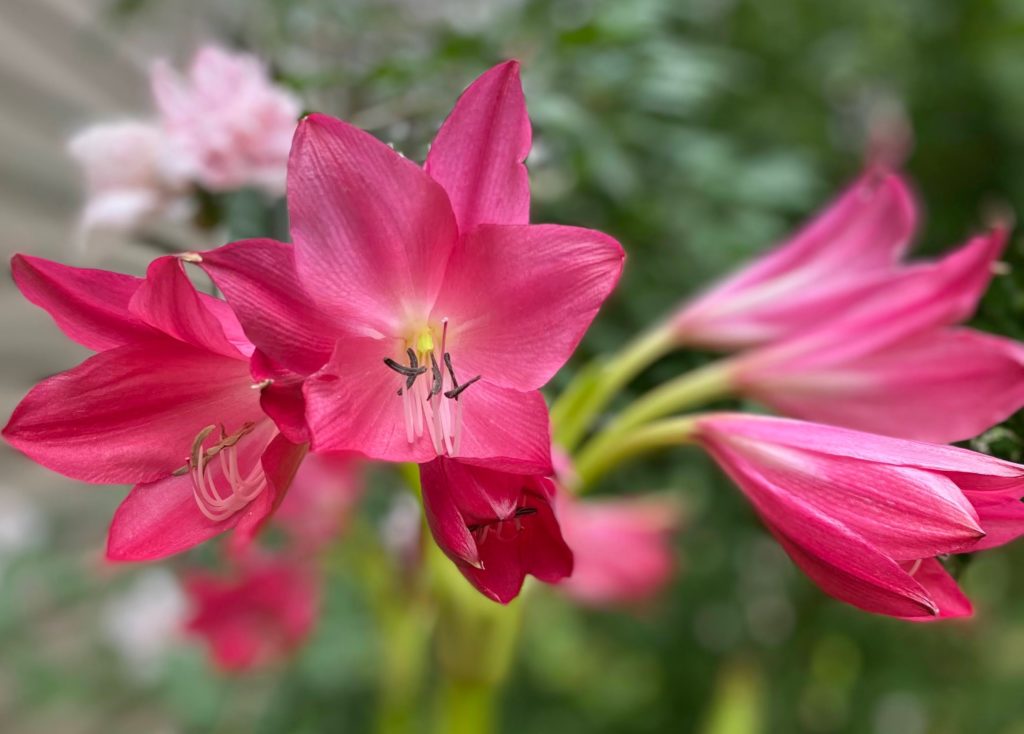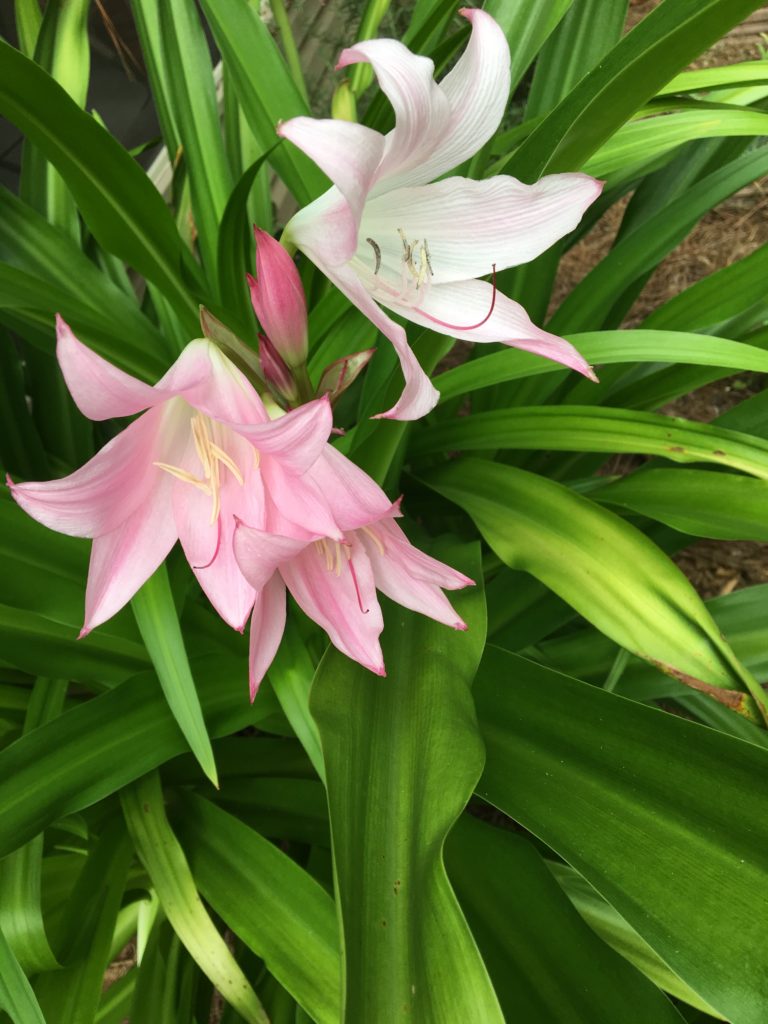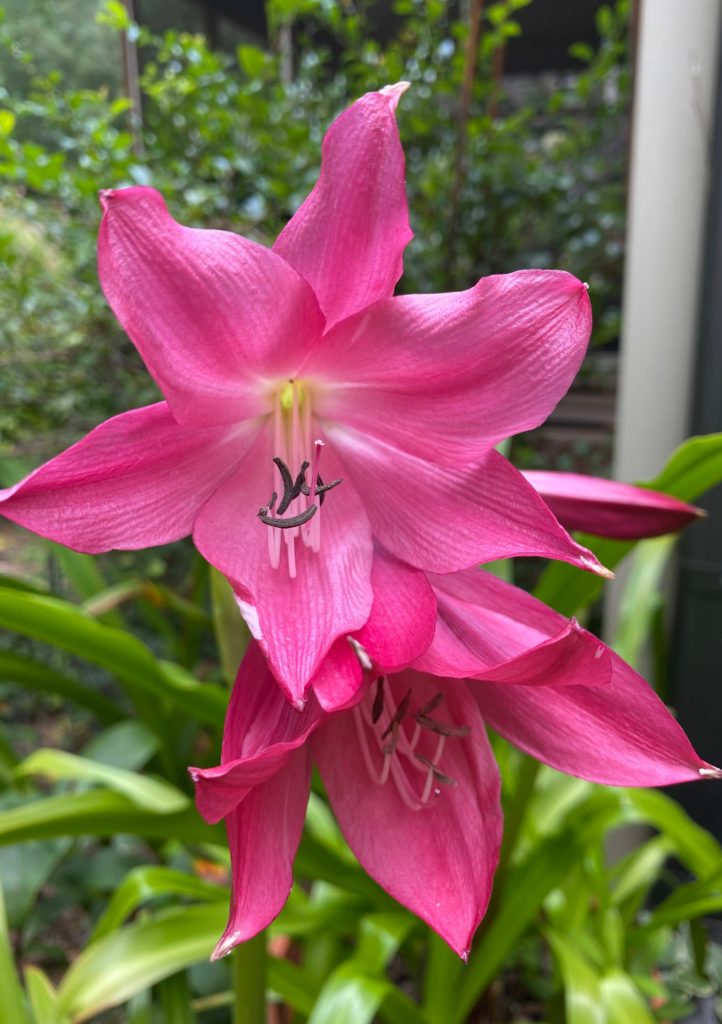
The crinum lily is a strange and wonderful creature. She’s exotic when combined with a few of those heat-loving plants Southerners love (cannas, elephant ears, hibiscus), and elegant when placed in a summer border filled with agapanthus, summer phlox, and hydrangeas.
I was lucky enough to find three tiny crinum lilies already growing in the back yard when we moved to our Georgia home several years ago. It took me a full year to identify them as crinum lilies (having assumed they were some type of amaryllis), and another year to see them bloom.
This is not to say that these lilies can’t be moved. A few years ago I decided to relocate my four crinum lilies (the original three, plus another I ordered on the web). I decided to give them their own garden border where they could spread over the years, and – let me be honest, I no longer wanted to see them in their dormant state in a flower bed just outside my kitchen window. The crinum is dramatic and showy when in bloom, and the foliage is attractive for many months, but in late November when a hard frost takes it to the ground…..well, let’s just say there is no winter interest with this genus, at least not here in zone 8. (This is remedied with a pair of waterproof gloves, sharp pruners, and a very large bucket with which to dispatch the slimy mess to the compost pile. )
The day I relocated my crinum lilies I was astounded at the size and number of tubers that I was able to dig up. By dig up, I don’t mean dig down a foot or so with your spade and pop out a rootball. This is akin to digging a trench for a French drain. Needless to say, moving a crinum lily is a task for the cool weather of late fall or very early spring.

Where to Plant Crinum Lilies and How to Care for Them
I chose to replant my lilies on the sunny west side of my house which is not completely visible from the street, but where I can still appreciate the blooms when they are at their best. In summer, visitors approaching my house see the enormous, trumpet-shaped blooms leaning out from the border and wonder, what are those huge pink flowers? In my zone, the lilies start to bloom in July, sending up a new scape every now and then. I cut off the spent flower scapes to the base of the plant to keep them looking attractive, and if I wanted perfection I would remove any spent petals each morning, but I seldom do. Crinum lily foliage is attractive well into the fall as long as the plant is watered regularly.
After living with these plants for several years, I’ve decided they will always have a place in my garden. The deer and rabbits ignore them and they work well in an area of my garden that is sometimes damp. Crinum lilies are said to love sun and moisture, but once established they’re quite drought tolerant because of their enormous root systems. That being said, in my experience, they always look healthier with consistent water. I feed them twice a year with organic flower fertilizer, once in the spring, and once around the time they begin to bloom. In the winter, when the bulbs are dormant, I’ll give them a blanket of loose pine straw, and I won’t look at them again until spring arrives. They tend to wake up earlier than they should in my garden, and leaf tips tend to get burned by the inevitable late March frost, but any damage will just peel away as the leaves expand in spring.

Crinums in Containers
This year I’ve experimented with a few extra bulbs by planting them in large containers placed at the corner of my house near a large panicle hydrangea. I’ve placed the containers very close to a water source, which means that it is easy for me to keep them watered. They’re thriving, which means that I’ll be digging up a few more from a holding area in the woods where I stashed the extras that I had no use for. (I couldn’t bear to compost all of the extra tubers and didn’t have time to find new homes for them, so I quickly dug holes and shoved them in the ground at the end of a long afternoon of crinum moving. Every single tuber survived, despite their rough treatment, and a few of them even bloomed the next summer in the middle of the woods, with no sun or water, a testament to their tough nature.)
Next year I’m planning to insert pots of crinum lilies in various places in my garden where I need extra color in July and August. I might also put a pot on my front porch, which holds a summer collection of tropical-looking plants such as colocasia (elephant ear), eucomis (pineapple lily), and abutilon (flowering maple).
More on Crinum Lilies and Other Cool Bulbs
If you want to take a deep dive into the world of crinum lilies, please check out Jenks Farmer’s excellent website www.jenksfarmer.com. I first discovered Jenks while reading a column he wrote for Garden Rant, one of my favorite garden blogs. He has a new book out called Crinum, Unearthing the History and Cultivation of the World’s Biggest Bulb. I’ll certainly be adding that to my library of gardening books this year, and if it sounds interesting you can order directly from the Jenks Farmer website. (And while you’re on there, you might as well order a bulb or two….)